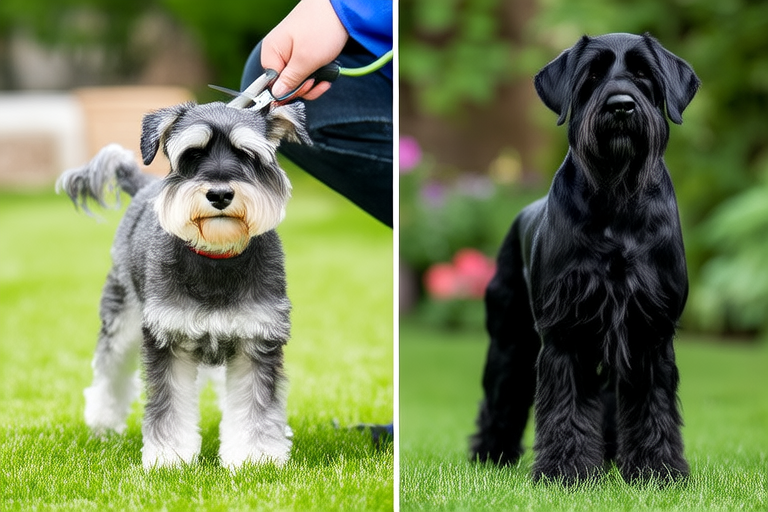From Puppies to Adults: A Visual Journey of Schnauzer Growth
The Schnauzer, a breed known for its distinctive facial hair and robust build, has captured the hearts of many dog lovers around the world. With their intelligent gaze and charming demeanor, these dogs are more than just pets; they are companions that offer unwavering loyalty and a touch of elegance. Their versatility in size—ranging from the compact Miniature Schnauzer to the larger Standard Schnauzer—makes them adaptable to various living environments. This article embarks on a visual journey, exploring the remarkable transformation of Schnauzers from tiny, vulnerable puppies to fully grown, confident adults.
Newborn Schnauzers: The Fragile Beginnings
At birth, Schnauzer puppies are incredibly small, weighing between 0.5 to 1 pound. Their eyes and ears are sealed shut, and they rely entirely on their mother for warmth and nourishment. Imagine a litter of wriggling, blind bundles, each one no bigger than your hand. Their soft, fine fur is often darker than it will be later in life, giving them a uniform appearance that makes distinguishing between littermates challenging. The bond between mother and pups is immediate and intense, as she licks them clean and encourages them to nurse.
Puppyhood: The Early Weeks
By the time Schnauzer puppies reach four weeks old, they have opened their eyes and begun to explore their surroundings. Their playful curiosity is evident as they tumble over each other, learning coordination and social skills. The pups’ coats start to develop their signature wiry texture, though they still maintain a softer undercoat. Their faces begin to show the beginnings of their unique beards, which will eventually become their hallmark feature. During this period, regular vaccinations and deworming are crucial to ensure their health and well-being.
The Juvenile Stage: Growing Up Fast
Between three to six months, Schnauzer puppies experience rapid growth. They are full of energy, constantly testing boundaries and learning about the world. Their bodies lengthen, and their legs grow stronger, enabling them to run and play with greater agility. At this stage, their temperament starts to become more pronounced, revealing whether they are more active or laid-back. Training is essential during this period to guide their behavior and establish good habits. Regular grooming becomes necessary to manage their growing coats and keep their skin healthy.
Adolescence: Becoming Independent
As Schnauzers enter adolescence, typically between six months to a year, they become more independent and assertive. Their growth slows down, but their confidence grows. Their coats thicken and darken, taking on the characteristic coloration that will define their adult appearance. Adolescents can be a bit rebellious, testing limits and sometimes ignoring commands. It’s important for owners to remain patient and consistent with training. Socialization remains key during this phase, helping them adapt to various environments and people.
Young Adulthood: Maturing into Their Role
Between one and two years of age, Schnauzers transition into young adulthood. Their physical development is nearly complete, and they exhibit a more refined version of their adult selves. Their coats are fully developed, and their trademark beards are well established. Mentally, they are more settled, showing greater focus and understanding of commands. This is the ideal time to introduce more complex tasks or sports like agility training. Their energy levels are high, so regular exercise is necessary to keep them fit and happy.
Senior Schnauzers: The Golden Years
As Schnauzers enter their senior years, usually around seven years and older, their activity levels decrease, and they may require more gentle handling. Their coats may thin slightly, and their movement might become slower. Despite these changes, their intelligence and affection remain unchanged. Regular vet check-ups are vital to monitor their health and address any age-related issues promptly. Senior Schnauzers thrive on routine and familiar surroundings, making them perfect companions for those who can provide a stable environment.
Care Needs Across Stages
Throughout their lives, Schnauzers require different levels of care. As puppies, they need frequent feeding and attention to ensure proper growth. Juveniles benefit from structured play and training sessions. Adolescents need firm guidance and consistent routines. Young adults enjoy challenges that stimulate their minds and bodies. Seniors require gentle handling and extra medical care. Regardless of the stage, grooming is a constant necessity due to their dense, wiry coats.
Advice for Prospective Owners
Owning a Schnauzer is a rewarding experience, but it comes with responsibilities. From the early days of nurturing fragile puppies to the serene companionship of senior dogs, each stage brings unique joys and challenges. New owners should be prepared for the commitment, understanding that Schnauzers are not just pets but lifelong companions. Patience, love, and dedication are key to raising a happy and healthy Schnauzer. By being aware of their needs at every stage, you can ensure that your Schnauzer enjoys a fulfilling and joyful life.
